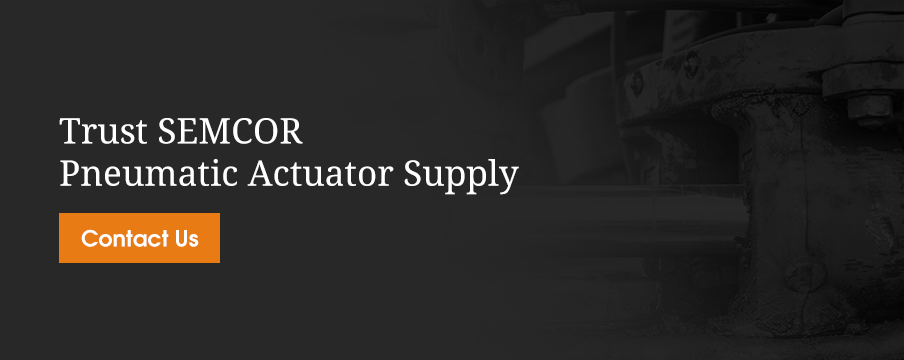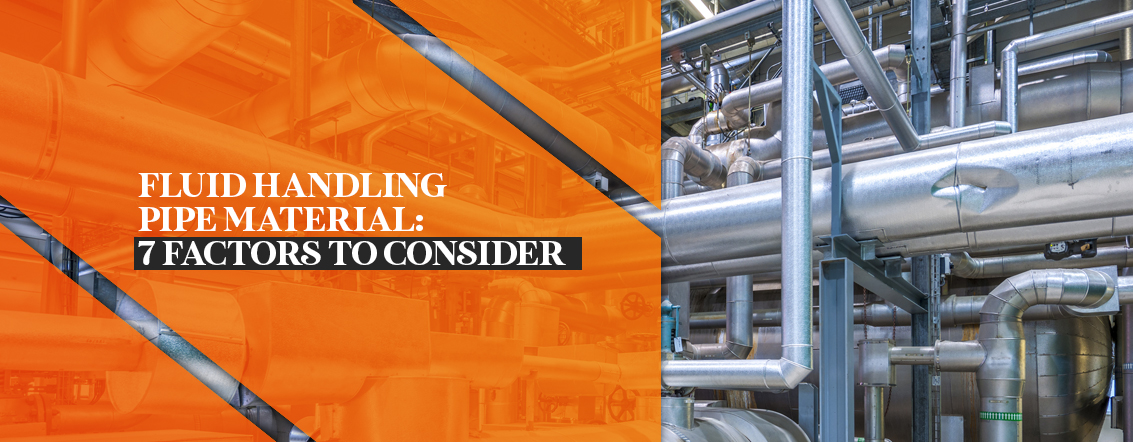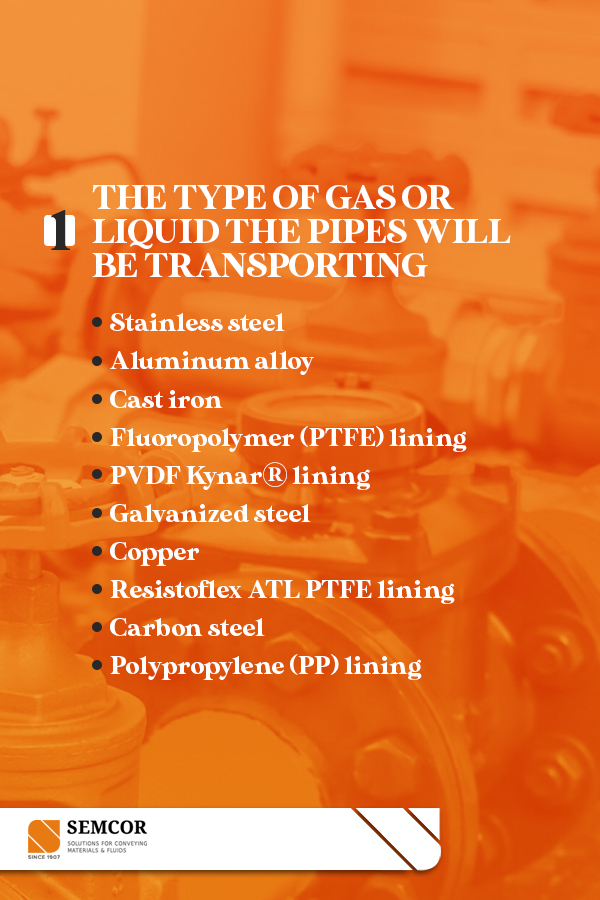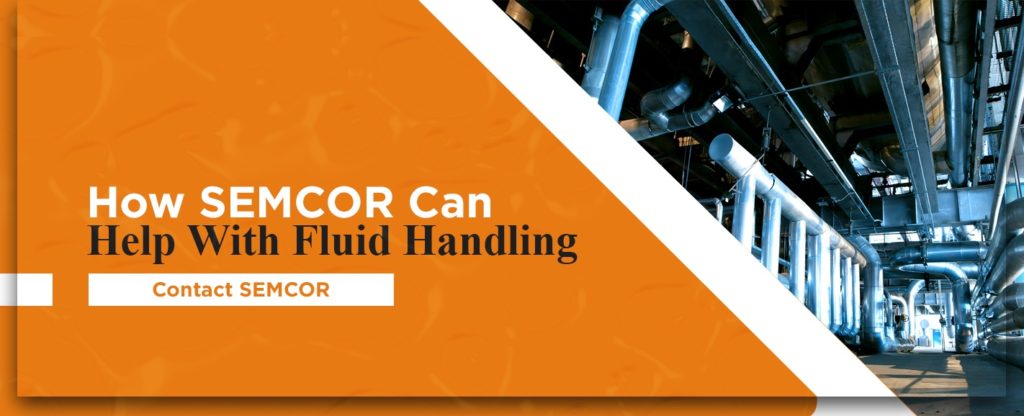Preventing Corrosion in Industrial Pipe and Fittings

Pipe corrosion costs you money and productivity. Monetary costs come from direct damage from leaks, indirect damage from lost work and regular maintenance of pipe and fittings.
To prevent losses from corrosion and the damage it causes, you must know why it happens in industrial pipe and fittings. With basic prevention, you can save your facility the time and lost work of broken or leaking pipes.
Why Corrosion Occurs in Industrial Settings
In industrial settings, corrosion happens when metal breaks down as energy transfers from one material to another. The type of corrosion depends on the metal and environmental conditions. Several types of corrosion exist – galvanic, chemical, electrical, microorganism and stress crack. Each has its own reason for occurring and means for prevention.
1. Galvanic Corrosion
Galvanic corrosion may occur when dissimilar metals adjoin with a conducting material between them. One of the metals will stay protected while the other corrodes. This form of corrosion often occurs when a more refined, high-energy metal, such as iron, passes its energy to a less refined metal, like copper, through the environment.
Soil and water can both carry energy from one metal to another, leading to corrosion. The higher energy metal will become an anode and contribute electrons to the lower energy metal, which acts as the cathode. This movement of electrons leads to the corrosion of the high-energy metal and protection of the low-energy one.
Setting up sacrificial anodes near steel pipes or other metals protects the pipe by converting it into a cathode, while the sacrificial metal anodes corrode.
2. Chemical
Acid attacking the metal piping creates chemical corrosion. Typically, this may happen at facilities that handle strong chemicals with low pH values. Often, the chemical wear happens under the insulation of the piping. Protecting the metal from chemical contact is critical in preventing pipe corrosion of this type.
3. Electrical
Pipes exposed to AC or DC current may experience corrosion. Pipes underground running near trolley lines with DC power or high-voltage electric lines with AC current may corrode from the electricity flowing through the pipe and leaving through the soil. Where the pipe changes direction, the current which had moved along the pipe in a straight line leaves and flows through the soil. The turning point of the pipe typically is where the corrosion occurs.
4. Microorganism
Some microorganisms can directly attack the metal inside pipes by consuming the material itself. Another way bacteria damage pipes and fittings is through the chemical byproducts they produce. Either of these methods eats into the metal, and to prevent the damage, you need antimicrobial products inside the pipe.
5. Stress Crack
Cracking along the grain of metal is a form of stress-induced corrosion. Most often, this form of damage occurs in high-strength metals when conditions meet a series of requirements – corrosion-likely environment, high-tensile stress and an alloy prone to the stress. Damage typically forms along the grain lines as corrosion reduces the metal’s resistance to cracking.
Pitting vs. Crevice Corrosion
When it comes to the differences between crevice and pitting corrosion, there is a fine distinction based on the location of the damage and conditions that caused it.
Pitting happens at random locations along the surface of the metal. Most often, this happens in areas of slow flow or stagnant liquid. Understanding this form of damage is crucial when working to prevent liquid handling corrosion. Keeping fluids moving through pipes can reduce the chances of pitting corrosion.
Though the appearance of crevice corrosion resembles the pits seen in the pitting form of damage, the location will determine if you have crevice or pitting corrosion. This form of pipe corrosion happens at junctures between pipe and fittings such as at bolts, joints and gaskets.
How to Prevent Corrosion

While some causes of pipe corrosion are easier to prevent than others by keeping the conditions that cause the damage at bay, you still need to take action to stop all forms of damage. Prevention is the key to avoiding the costly damage from breaches in the pipe structure. With good care and prevention, pipe, even heavily used petroleum pipelines, can last for decades.
1. Preventative Maintenance
Preventative maintenance that includes inspections goes a long way toward keeping pipe and fittings intact.
Whether dealing with chemical or water pipe corrosion, the type of pipe and fittings will determine the form of prevention you need to take. For example, galvanic corrosion prevention may require the inclusion of a sacrifice metal. To keep microorganism-caused damage away, treat the fluid inside the pipe with antimicrobial substances. Keeping your pipes safe from chemical erosion may require the use of lined pipe. Keeping metal pipe and fittings away from electrical sources such as underground power lines will prevent electrical damage.
If using dissimilar metals for pipe and fittings, you must insulate the two metals from each other to prevent currents from flowing between the metals and causing corrosion.
2. Select the Right Material for Your Operation
Choosing the correct material to prevent both internal and external corrosion is another critical step to make. When it comes to lined pipe, you have multiple options to choose from. However, some options perform better at preventing corrosion than others in certain circumstances.
To keep chemical corrosion away, use polyvinylidene fluoride (PVDF) lined pipe and fittings. This material has a high resistance to chemical damage. It can also handle a wide range of temperatures from -140 degrees Fahrenheit to 275 degrees Fahrenheit. You may also use this to stay within USDA and FDA regulations for food-handling products.
For resistance to almost all chemicals and temperatures up to 450 degrees Fahrenheit, use the multipurpose polytetrafluoroethylene (PTFE) lined pipe and fittings. This premium lined piping keeps products inside pure while preventing leaks and corrosion due to its outstanding resiliency.
As an alternative to Resistoflex PTFE-lined pipe, use Resistoflex ALT PTFE-lined pipe and fittings. This lining offers even greater resistance to corrosion and up to 60% more protection against permeation. Its designer specifically made this lined piping to hold up to the most rigorous industrial fluid handling needs of power plants and pulp and paper making facilities.
Not all industrial applications require the strongest lining inside piping. For a more economical option that can handle temperatures up to 225 degrees Fahrenheit, use polypropylene (PP) lined pipe.
Locate a Lined Pipe and Fittings Supplier
Preventing pipe corrosion will save you direct and indirect costs from leaks. While regular maintenance helps, having the right pipe and fittings does more to delay industrial piping corrosion. To move forward with your business, you must correct any problems causing delays in operations, including replacing old, worn pipe and fittings with lined alternatives to resist future damage from corrosion. Lined pipe and fittings from SEMCOR are key to maintaining your facility’s efficiency. Whether your operation needs an off-the-shelf solution or a part modified to fit your needs, contact us at SEMCOR.
How Pneumatic Actuators Work and Advantages of Pneumatic Actuators
Pneumatic Actuators Explained
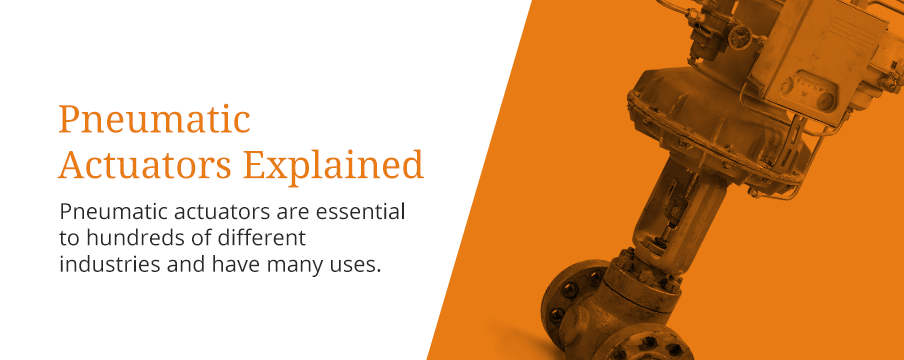
Pneumatic actuators are essential to hundreds of different industries and have many uses. To understand how you can apply pneumatic cylinders, you should familiarize yourself with the fundamentals.
This guide will answer the questions: what is a pneumatic actuator, how does an actuator work, what are the different types available and what is the function of a pneumatic actuator?
What Is a Pneumatic Actuation System?
Pneumatic actuators are highly reliable, efficient and safe sources of motion control that use pressurized air or gas to convert energy into rotary or linear motion. They’re especially appropriate for the repeated opening and closing of valves and other industrial applications where the use of electricity may cause a fire or ignition hazard. Actuators are commonly used to control the valves that direct the movement of fluids in the chemical and process industries.
Pneumatic actuators have several different names, including pneumatic cylinders, air cylinders and air actuators. Each of these terms is synonymous with the other, as they all identify the device as air pressure based. Another name for an air cylinder is pneumatic ram, in which the ram is referring to the linear piston.
How Does a Pneumatic Actuator Work?
Pneumatic actuators rely on some form of pressurized gas — most often compressed air — entering a chamber, where the gas builds up pressure. When it has built up enough pressure in contrast to the outside atmospheric pressure, it results in the controlled kinetic movement of a device such as a piston or gear. This resulting movement can be directed in either a straight line or circular motion.
Since the conversion of compressed gas into energy can be highly controlled and is reliable and repeatable, pneumatic actuators are one of the most popular mechanical devices used in a wide array of modern industries.
Types of Pneumatic Cylinders
There are two primary varieties of pneumatic linear actuators — single-acting and double-acting. They both work to push forward a piston, but the main differences are the return method and number of ports.
Single-acting cylinders have one port that allows air to flow into the cylinder. The pressure increases and pushes the piston forward or backward, depending on whether it is a push or pull type. A large spring returns the piston to its original position, preparing it for another burst of pressure. The spring is either positioned inside the cylinder or on the outside.
Double-acting cylinders operate without a spring and instead have two ports, one on either end of the piston. The first application of pressure pushes the piston forward, a step in the process that the two models share. Then, the second burst of pressure on the other side of the cylinder pushes the piston back into place. The device applies pressure back and forth to create a smooth linear motion.
Typically, double-action cylinders are better for industrial uses that require speed and strength, as they provide more force at a faster rate. They may also offer a longer lifespan before needing replacement. However, they are a more expensive option in comparison. Single action cylinders also have other advantages besides cost. They have a more straightforward design, are more compact and require half the amount of compressed air to function.
Pneumatic Actuator Applications
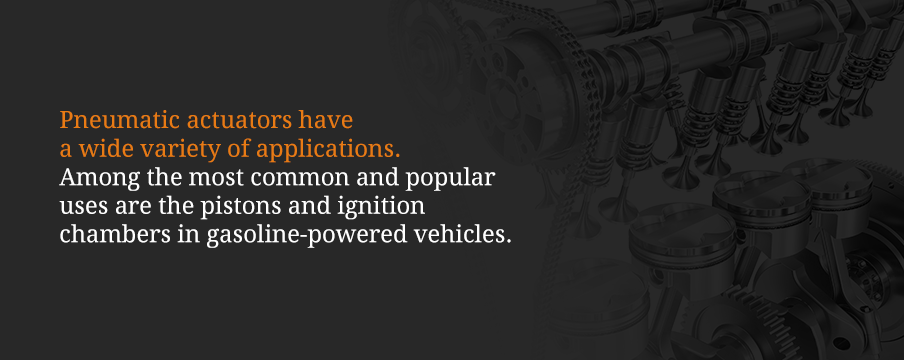
Pneumatic actuators have a wide variety of applications. Among the most common and popular uses are the pistons and ignition chambers in gasoline-powered vehicles. They use ignition of the air and gasoline to create the pressurized force that eventually moves the piston and converts energy into the car’s crankshaft. However, the majority of pneumatic actuators rely only on pressurized gas with no ignition to produce the desired mechanical force.
In addition to the conventional combustible automobile engine, pneumatic actuators are essential in air compressors, packaging and production machinery, mail tubes and transportation equipment like railway and aircraft applications. They’re crucial in many other industrial situations that call for switch, pump or sensor control as well.
Pneumatic vs. Electric Actuators
While pneumatic cylinders work by way of pressurized air, electric actuators use electricity to function. Electric actuators are made up of a screw, coupler and motor, such as a stepper or servo. The screw turns and moves a nut, which makes the connecting rod or carriage shift the load. While pneumatic and electric actuators have similar uses, they aren’t directly interchangeable in every industry.
These two types of actuators vary in several other ways:
- Cost: Overall, pneumatic actuators have lower initial costs than the electric variety, but each has their purposes, and either could end up saving money in operating costs. Pneumatic cylinders are the most cost-efficient when the compressor size matches the number of cylinders it’s powering. Electric actuators provide the highest level of efficiency in moderate scales, though they have low operating costs in general.
- Force: In pneumatic actuators, speed and thrust are positively linked, meaning as one increases, the other does as well. In electric actuators, thrust and speed do not have the same link, as one decreases as the other increases. You can engineer them to perform differently, but it requires higher expenses.
- Control: Where pneumatic cylinders are better for industries that need force, electric actuators provide more accurate control and positioning. The standard models of the electric variety can move with precision from hundredths to thousandths of an inch.
Advantages of Pneumatic Actuators
The benefits of pneumatic actuators stem from both their overall safety and reliability. First of all, since pneumatic actuators can convert energy into motion without ignition or electricity, they’re highly sought after in situations where sparking and combustion cannot be tolerated. In these settings, compressed air can be stored and used in an efficient and repeatable manner that poses no fire risk.
Second, since pneumatic actuators that don’t rely on combustion can be manufactured easily and are relatively simple devices, they are also extremely durable, have minimal maintenance needs and offer a long operational life when used correctly.
Trust SEMCOR Pneumatic Actuator Supply
As one of the most reliable distributors of pneumatic actuators, SEMCOR is ready to supply you with the equipment you need from leading manufacturers. In addition, thanks to our outstanding expertise and customer care, the technical support that comes with all our actuators is unbeatable. Contact us now for product descriptions, selection guidance and more.
How Does a Pressure Transducer Work?
How Does a Pressure Transducer Work?

Pressure transducers are necessary for many industries. They measure pressure and create an electrical output proportional to the input. But with several different types of available models and many uses, it may be challenging to know how to choose the right model for your purposes. This guide will take you through what transducers are, how they work, the different types and potential applications.
What Is a Pressure Transducer?
A pressure transducer, sometimes referred to as a transmitter, is a device that turns pressure into an equally proportional electrical signal. Transducers use variable pressure sensors to measure deflection and resistance. The produced signal will be either a voltage, current or frequency, based on the applied pressure. Most types also require an electrical input, also called excitation. Transducers typically produce one of three types of output — millivolt (mV), voltage (V) and milliampere (mA).
How Does a Pressure Transducer Work?
The majority of transducers have a pressure-sensitive element that reacts to pressure entering through the transducer’s pressure port. As the sensing element or diaphragm is deflected due to the pressure’s force, it moves in relation to a resistor or capacitor plate. This, in turn, sends an output signal that is determined by the varying tension between the input signal, diaphragm position and core resistance.
There are three main types of transducer:
- Potentiometric pressure transducer: Potentiometric sensors are comprised of a precise potentiometer with an arm attached to a Bourdon or bellows. As the arm moves across the potentiometer, it converts the deflection into a measurement of resistance. The nature of these transducers allows them to be small in size and to work in tight spaces. They also produce a strong output, making them excellent for applications with low power.
- Capacitance pressure transducer: Capacitance sensors are sensitive and responsive, using a diaphragm transducer model to measure resistance. The diaphragm has a small space to travel, which means they work well in applications with low differential and absolute pressures.
- Resonant wire pressure transducer: Resonant wire transducers measure pressure with a wire attached to the sensor diaphragm. As the wire oscillates, pressure changes affect its tension, changing the frequency at which the wire is resonating. It results in exact measurements, and the transducer works well for applications with low differential pressures.
Depending on the model, transducers have a range of pressures they can measure and convert with accuracy. They operate best at between 50% and 60% of their maximum rated pressure. So, for a system operating at about 2,500 to 3,000 pounds per square inch (psi), a 5,000 psi rated transducer would work well.
Can External Factors Impact Pressure Transducers?

While most transducers are designed to produce a linear output in relation to the pressures they encounter, certain external variables can have an impact on their output signals. Nothing affects transducers more than temperature. That’s why almost all transducers are manufactured to be functionally accurate within a given temperature range. This sensitivity is due to the fact that as temperatures increase or decrease, there’s a resulting expansion or contraction in fluids and materials, which can change both the transducer’s mechanical and electrical properties and alter its calibration.
They also have a sensitivity to electromagnetic interference (EMI). If there are high field strengths present, it may change the pressure transducer’s electrical output. Fields strong enough to saturate the internal amplifiers can cause the transducer to produce inaccurate outputs, regardless of the amount of pressure. You can measure for external EMI and solve interference issues through shielding, grounding and routing techniques.
Different Types of Electrical Outputs
Pressure transducers are often differentiated by the electrical signal they create. There are three main types of available electrical output:
- Millivolt output transducers: The most economical choice of the three, mV transducers have a low electrical output. The exact output depends on the excitation levels. Since they have a low output signal, they’re susceptible to external electrical noise, making them better for non-industrial environments.
- Voltage output transducers: If you need a higher output level, consider voltage transducers. The actual output will depend on the model, but it is less dependent on excitation levels. Voltage output transducers are less affected by external electric sources, so they’re better for industrial environments.
- 4-20mA output transducers: Also known as pressure transmitters, the 4-20mA transducers produce a strong signal and can transmit them over long distances. They’re the least prone to electrical interference.
Pressure Transducer Applications
The types of transducers and their applications are as varied as the many industries that employ them. Four factors help determine which type of pressure transducer or transmitter needs to be installed in any given system:
- The particular device (e.g., programmable controller, microprocessor, panel meter) to which the transducer will be sending its output signal.
- The amount of EMI (electromagnetic interference) that will be encountered, such as in welding, power line and motor applications.
- The overall distance from the original pressure measurement and output signal to the device that will eventually receive the signal. Note: Transducers are the optimum choice for shorter distances, while transmitters are typically used in applications requiring sending signals over longer distances.
- The cost of the overall system and its installation.
Transducers are necessary for HVAC compressors and filtering, robotics and automation equipment, industrial transport and lifts, hydraulic feedback in weighing/scale systems and heavy-duty vehicles and power plants and fluid fuel systems.
Trust SEMCOR Transducer Supply
When it comes to expert advice on transducers, a large inventory, prompt delivery and superior technical support, look no further than SEMCOR. We’re your leading supplier of pressure transducers and transmitters from top manufacturers you can trust. Contact our sales and service staff for more product information and answers to all of your questions.
Ball Valve vs. Butterfly Valve

Engineers who need to control the flow of a gas or liquid often turn to ball valves and butterfly valves. Both are quarter-turn rotary valves that are inexpensive and durable. They are both excellent for regulating flow at a wide range of temperatures. So, what’s the difference between a ball and butterfly valve?
Though the differences are subtle, they each have unique characteristics that make them ideal for specific applications. Factors like pressure differences, quality of seal and supply pipe size can make either a butterfly or ball valve more beneficial for a project.
Ball Valves
A ball valve consists of a floating ball with a hole running through it. When the valve is activated, the hole is aligned in a way that blocks, partially blocks or completely opens the flow of liquid or gas. There are several benefits to using ball valves, including the tight seal, which is ideal for applications involving gas flow. They are often used in high-pressure liquid or gas lines that are less than 6 inches in diameter. Ball valves offer almost no resistance when turning them, even if the supply side is creating high pressure. Some designs provide no drops in pressure. Most ball valves can operate in temperatures between -30℃ to 230℃. There are several kinds of ball valves, including:
- Full-port ball valve: The hole in the ball is the same size as the pipeline, providing an uninterrupted flow. In this approach, no friction loss occurs due to different opening sizes.
- Reduced-port ball valve: The hole in the ball is slightly smaller than the pipe, which somewhat restricts flow. This design increases the velocity of the flow and makes the valve less expensive.
- V-port ball valve: In this design, the ball or seat is V-shaped. As the valve is activated, the small end of the V opens first, providing a more stable flow. Many choose to use these valves in applications where more control or high velocity is required. They tend to have a more sturdy construction that can hold up against high velocities that may ruin another valve.
- Cavity filler ball valve: For some applications, such as those in food production or healthcare, the residue that stays inside a ball valve can become a health hazard. Changing the fluid that goes through the pipe could lead to contamination issues, as well. A cavity filler plugs the hole by extending the seats, preventing these buildups from occurring.
- Trunnion ball valve: The ball is anchored to the top and bottom of the valve. This design is often required in large-scale or high-pressure applications to prevent the ball from floating off and causing problems with the seating mechanism.
Butterfly Valves
Butterfly valves are a lightweight valve that comes in one- and two-piece designs, named after their resemblance to the wings of a butterfly. In the two-piece design version of these valves, the sections fold inward to allow full flow and lie flat when closed. In a one-piece design, a disk is mounted on a shaft that rotates around the pipe. Activating the valve turns the disk to fully open or block the flow of gas or liquid through the valve. Butterfly valves are usually one of two types: lug and wafer valves. These two types mainly differ in their installation designs.
- Wafer valves: Wafer valves are fairly standard and often less expensive than lug valves. The valve is installed between two flanges with bolts or studs and nuts. With this design, you cannot disconnect one side of the piping, but if that is not required, wafer butterfly valves are an excellent option.
- Lug valves: For a less permanent fixture, lug butterfly valves use threaded metal inserts in the bolt holes of the valve, so no nuts are required. A separate set of bolts goes on either side of the flange. This design allows you to disconnect one side of the piping system and leave the other side untouched.
These valves are typically less expensive in terms of materials and maintenance. They are also lighter than ball valves and are faster to open and close. They are often used in large-scale projects, such as municipal water systems and sewers. Applications that require the control of flow from a body of water often use butterfly valves. If flow loss is not an issue, then butterfly valves are excellent for controlling flow and pressure. Another benefit of butterfly valves is that they are smaller than ball valves, which is useful for projects that need to minimize space.
How Ball Valves Differ From Butterfly Valves
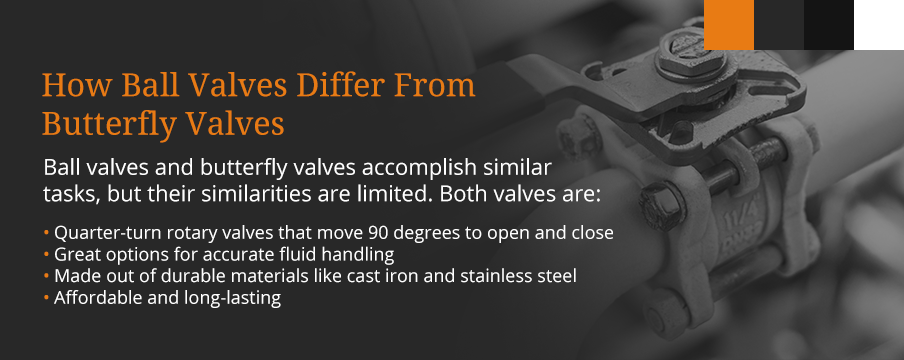
Ball valves and butterfly valves accomplish similar tasks, but their similarities are limited. Both valves are:
- Quarter-turn rotary valves that move 90 degrees to open and close
- Great options for accurate fluid handling
- Made out of durable materials like cast iron and stainless steel
- Affordable and long-lasting
The primary difference between the valves lies in their effect on flow. In butterfly valves, part of the disk interferes with the flow, creating a drop in pressure. For applications where consistent or high pressure is needed, this, of course, is a disadvantage. The pressure change can also make the valve difficult to operate due to the incoming pressure from the supply side. A bypass valve could be needed to balance out the pressure before a butterfly valve can work appropriately. Alternatively, the ball valve offers 100 percent flow with its design. It can be used for projects where higher pressure is needed.
Another consideration is the size of the application. Due to their design, ball valves typically become less cost-effective at around 6 inches in diameter. At that point, butterfly valves generally are the more economical choice. They are lighter and tend to be more affordable. These characteristics make them great for large-scale projects where flow control is less of a concern. Plus, butterfly valves don’t trap fluids like a ball valve can, so a butterfly valve may be better for applications in food production, where residues can create health hazards.
Find a Valve Supplier
The uses for both ball and butterfly valves are extensive, and they are each widely used across industries. They are simple to install and typically made of durable materials. Both ball and butterfly valves are available at low costs. At SEMCOR, we pride ourselves on providing long-lasting equipment that requires as little maintenance as possible. We offer valves from AMRI, Apollo, Richter, ITT and more.
We’ve been in business for more than a century, and over the years, we’ve learned what makes a good product. Dependability, durability and affordability are among our top considerations. If we don’t have a valve that meets your needs, we can even create a custom-made valve for your project. Reach out today for more information on our process and product options.
Selecting the Right Pipe Material

How to Select the Right Pipe Material for Fluid Handling Operations
At manufacturing plants and other industrial locations, many parts are involved in the success of the entire operation. One of those components is the fluid handling system throughout the building — the piping that runs along the walls, ceiling and potentially underground to provide the facility with water, oil and other fluids that are necessary to complete certain processes.
Like any system, the pipe and fittings involved in your fluid handling operations will eventually need to be replaced. If you’re building a new facility, you get to start from scratch and choose the best piping material for your needs. Whether you’re replacing your fluid handling system or installing one at a brand-new building, there are several factors you should consider before starting, as well as multiple pipe material options to choose from.
When implementing or constructing a fluid handling system in your plant or warehouse, you will have to make several decisions based on your industry, handled materials and objective. One of the most important decisions you will make during this process is the type of pipe material you need to transport your liquids, gases, chemicals and other fluids. This is not a decision to make lightly — the wrong pipe material could jeopardize the quality of your product, as well as the safety of you and your employees.
Here are seven factors to consider when choosing the best pipe material for your fluid handling system.
8 Elements to Consider When Selecting Pipe Material
The material of the pipes in your fluid handling system has a direct impact on the overall success of the system, as well as your facility’s overall mission or goal. It’s critical to weigh all your options and account for the multiple factors that will affect the oil and water pipe material selection process. Here are eight things to consider before you choose your fluid handling pipe material.
1. Material Being Transported
What type of liquid are your pipes transporting? More specifically, is the liquid corrosive or non-corrosive? Corrosive liquids include substances such as crude oil, ammonia, seawater and other acidic liquids that have a heavy chemical makeup. These liquids require a corrosion-resistant pipe material such as a plastic CPVC pipe or lined pipe. Since most liquids are at least slightly corrosive, you will need a corrosion-resistant material for the pipes that will transport it. Meanwhile, non-corrosive fluids or gases like lube oil, air and nitrogen are safe to transport via carbon steel or metal pipelining.
The type of liquid or gas your pipe system transports plays a significant role in choosing fluid handling pipe material. Some pipe materials are better suited for non-corrosive liquids, like oils or standard wastewater. More corrosive liquids, like acid or peroxide, require a pipe with an interior that can hold up to the abrasiveness of these corrosive materials. Corrosive materials are common in many industrial cleaning solutions, as well as in chemical manufacturing and handling. Remember, despite a plastic or metal pipe material’s durability and corrosion resistance, chemicals, acids and saltwater are much more abrasive than standard water or oil. Always keep the liquid you are transporting in mind when selecting a pipe material.
Take a look at how the following popular pipe and pipe lining materials stand up to corrosion:
- Stainless steel: It’s called “stainless” steel for a reason — stainless steel does not rust or corrode as quickly or easily as other materials. It naturally resists most corrosion because it consists of several different alloys, all of which help form a protective oxide layer on the surface. This natural layer is tough and durable. For this reason, it is an ideal water pipe material selection that is also suitable for oils and some chemicals.
- Aluminum alloy: Aluminum does not rust, which is useful when you need your transported liquid to remain pure and uncontaminated. It can handle exposure to many gases, oils and liquids without deteriorating. However, aluminum does corrode over time, especially in saltwater or sulfuric applications.
- Cast iron: Cast iron is easy to find and is uniquely durable against many external sources of corrosion, like plant growth and soil, because it is so thick. Cast iron can withstand water and saltwater for short periods, so it could be suitable for short-term projects. However, it does corrode and rust after prolonged water exposure.
- Fluoropolymer (PTFE) lining: PTFE pipe lining is non-reactive and very resistant against corrosive chemicals. It is one of the most universally applicable pipe lining materials, and thanks to its durability and zero-risk of product contamination, it is the perfect acid, water, chemical and oil pipe material selection.
- PVDF Kynar® lining: PVDF pipe lining is very durable and strong, and is one of the most abrasion-resistance materials on the market. Manufacturing facilities or plants that handle high-strength acids, chemicals, saltwater and nuclear materials find success with PVDF lining. It also resists corrosion from natural sunlight and weathering.
- Galvanized steel: For short-term saltwater projects, galvanized steel is a suitable pipe material, as it does not rust. However, it will corrode after prolonged exposure to both salt and water. Also worth noting is that galvanized steel often corrodes from the inside out, so it may be challenging to detect.
- Copper: Copper is widely used due to its ready availability and aesthetic appeal. It is not completely immune to corrosion, but it is more corrosion resistant than many other materials, such as galvanized steel. Copper is most prone to corrosion in fresh and saltwater, as well as particularly harsh chemicals and acids.
- Resistoflex ATL PTFE lining: ATL PTFE pipe lining contains specially formulated resins that make it very strong and durable during prolonged exposure to saltwater and aggressive chemicals. It is often used in paper processing and power generation plants, as well as in the service industry.
- Carbon steel: Although carbon steel is ideal for high-temperature fluids, it does corrode easily under high levels of exposure to moisture, chemicals and acids.
- Polypropylene (PP) lining: PP pipe lining is a good high-temperature pipe material as it performs very well in temperatures as hot as 225 degrees, as well as saltwater and both basic and acidic applications. However, it does not withstand solvents, volatile organic compounds (VOCs) or excessively low temperatures. PP lining is often used in water treatment facilities, chemical processing plants, power generation facilities and food and beverage manufacturing.
2. Temperature of Liquid Passing Through
The next thing to consider is the temperature of the liquid in your fluid handling system. If you’re transporting high-temperature liquids, you’ll need to be sure your system consists of high-temperature pipe materials. Certain types of plastic piping may not be ideal for handling high temperatures, while others may be designed to handle fluids no matter how hot they are. Metal pipe materials are typically wise choices for high-temperature liquids, although some types may become too hot to the touch.
If you are handling extremely high or low-temperature fluid — including cryogenic liquids— make sur

e your pipe consists of material intended for extreme temperatures. Otherwise, you risk damaging or corroding your pipes and contaminating the liquids inside of them. In some cases, extreme temperatures can break your piping entirely, resulting in expensive repairs, damaged product and hazardous workplace conditions. Metal pipe material is usually suitable for extremely hot liquids, although you and your employees should exercise caution when working with them. Depending on the temperature, aluminum is often used to transport cryogenic liquids.
Your piping material must support these temperatures as well as maintain them throughout the liquid transfer process. In many applications — including laboratories, food processing, medical facilities and plants that work with hazardous chemicals — precise temperatures are required for all liquids and vapors used.
Some pipe materials that can be suitable for high temperatures include carbon steel, as well as PTFE, PVDF, ATL PTFE and PP pipe linings. For extremely low temperatures, copper, some aluminum alloys and high-alloy austenitic stainless steel are least likely to become brittle and break.
3. The Pressure of the Liquid Handling Process
What is the pressure of the fluids your system is handling? If the pressure of these service fluids is very high, you will need piping material that is either high-strength, higher thickness or designed to resist high-pressure fluids. The average pressure that most manufacturing facilities’ piping must be able to handle is around 150 pounds per square inch gauge (psig). If your facility is working with liquids of higher pressures than this, you may have to request a piping material that is specially designed to handle high-pressure fluids.
Various liquids and gases create different pressures inside of your fluid handling pipes. For example, cryogenic fluids are known for creating very high-pressure environments during the transfer process. Many external factors can impact this pressure, too, including the temperature and elevation of your piping.
Some liquids and gases that might require pressure-specific pipe materials include:
- Ammonia
- Chlorine
- Propane
- Carbon dioxide
- Nitrous oxide
- Acetylene
- Butane
- Hydrogen
- Helium
- Neon
- Nitrogen
- Concentrated oxygen
Make sure you choose a pipe material that is rated for high-pressure or low-pressure substances and conditions. If you use a high-pressure liquid or gas in a pipe that is not suited for high-pressure handling, you risk leaks, pipe bursts, flooding, fire, explosion and injury to property and personnel.
Never assume your fluid handling system is adequate for high-pressure substances. Always ask your pipe provider if your fluid handling system is designed to handle high-pressure fluids and vapors before use.
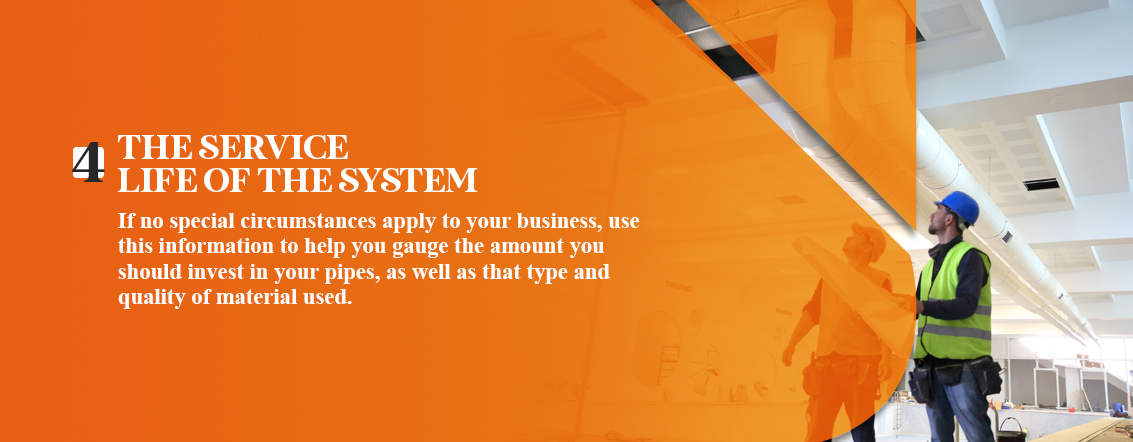
4. Service Life of the Fluid Handling System
You need reliable and durable piping, but how long do you need your fluid handling system to last? A major component of effective piping design and material selection is asking how long you expect your fluid handling system to last. If you know you’ll likely have to replace the system in five to 10 years due to another reason, such as relocation, you don’t need to invest in a very long-lasting piping material. This may also affect how much money you’re willing to spend on the system, which will, in turn, impact the type of material you should choose.
If, on the other hand, you expect this system to last for 10 or more years, you should invest in the most durable type of piping material.
For example, temporary worksites or processing plants that do not typically deal in fluid handling may not need as intricate or durable a system as a permanent plant that transfers fluids daily. You should also factor in how often your business will use your fluid handling system. Of course, there are some conditions — such as extremely corrosive chemicals, hazardous materials or fluids that need temperature regulation — that will require certain pipe materials, regardless of the desired service life of your system. If no special circumstances apply to your business, use this information to help you gauge the amount you should invest in your pipes, as well as that type and quality of material used.
5. Ease of Maintenance
Just like flooring, countertops and other solid surfaces, certain types of piping material are easier to clean than others. Ask yourself how often you can clean your fluid handling system. Be realistic about the frequency, as it is can become a very time-consuming task depending on the size and intricacy of your system. If you won’t be able to clean it very often, having a low-maintenance piping material should be a priority for your facility.

Make sure the material you choose for your fluid handling pipes is maintainable under your current circumstances. There are three main types of maintenance that all fluid handling systems should consider:
- Preventive maintenance: Preventive maintenance is necessary for all parts of your fluid handling system, and should be performed at regularly scheduled intervals based on the approximate cost of downtime, potential risks of system failure, expected time between part repairs and availability of backup equipment if necessary.
- Routine cleaning maintenance: Routine pipe cleaning maintenance will help prevent internal and external product build-up, which can corrode your system and contaminate transferred fluids.
- Emergency maintenance: Even with attentive preventive maintenance and highly durable products, you will likely require emergency or special repairs at least once in your fluid handling system’s life. Address concerns as they arise to reduce emergency maintenance visits.
During each of these maintenance scenarios, your pipes must be accessible. Always have a professional technician install your fluid handling system. Professional system technicians are trained to consider your system as a whole, rather than focus on singular parts or pieces of equipment. They will make sure your pipes are large enough for your space and business needs, but not oversized. Oversized pipe systems result in unnecessary maintenance and take up a lot of otherwise usable space.
If your business does not have the time, available workforce or budget for regular and frequent maintenance, choosing a low-maintenance pipe material should be your top priority.
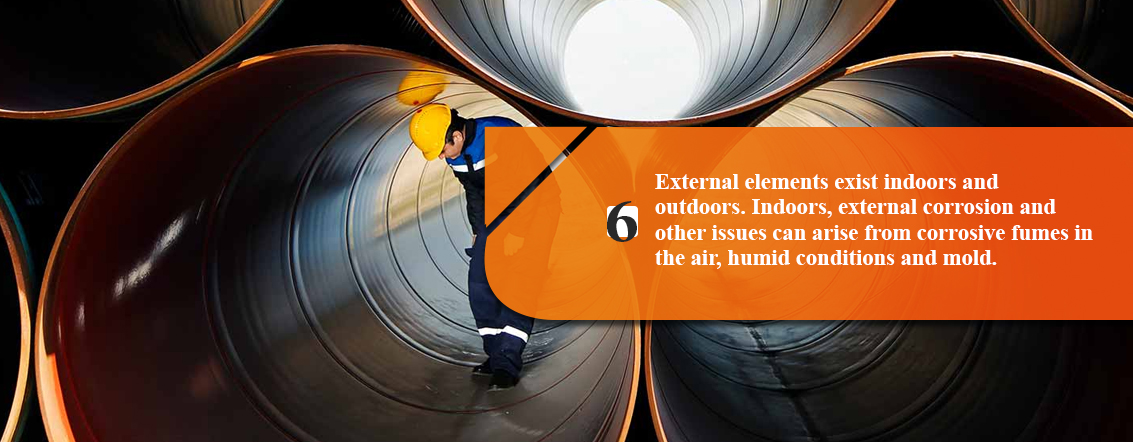
6. Exposure to External Elements
External elements exist indoors and outdoors. Indoors, external corrosion and other issues can arise from corrosive fumes in the air, humid conditions and mold. Outside poses several threats for external corrosion and damage, including the salt in seawater, inclement weather, microorganisms, plant overgrowth and more.
If any part of your fluid handling system is exposed outdoors, you need piping material that can withstand environmental elements. External elements that could lead to the deterioration or corrosion of your fluid handling piping include UV light, corrosive soil, precipitation and other atmospheric conditions.
Examples of external elements to be cautious of include the following:
- Corrosive fumes or vapors in the air from other work stations or materials
- Extreme or fluctuating temperatures, both indoors and outdoors
- Mold and mildew growth
- Salt from seawater
- Inclement weather, including rainfall, snow, lightning and hail
- Micro- and non-microorganisms that can burrow or corrode
- Plant, root and moss growth on outdoor piping
- Exposure to UV rays from the sun
- Corrosive and damp soil
7. Valve and Fitting Sizes
Certain piping materials will only have a few valve and fitting sizes to choose from, so you may need to eliminate some options based on this factor. Some of the valve and fitting types you can choose from include:
- Butterfly valves
- Ball valves
- Check valves
- Diaphragm valves
- Rupture pin safety valves
- Knife gate valves
- Solenoid valves
- Slurry valves
- Severe service valves
- Sanitary valves
The types of valve and fittings you choose will depend upon the types of connections you’ll need to make from pipe to pipe, as well as to connect the pipes to other features of the fluid handling system.
8. The Cost of the Material
Cost is a significant factor in any business decision. As you consider different pipe materials, keep in mind the cost of:
- The initial investment in all required parts, including the pipes, valves and pipe fittings
- Whether your chosen material is readily available or needs to be imported
- Routine and emergency maintenance appointments
- Pipe lining materials, if applicable
As with any expense, always consider the return on investment when comparing different costs. For example, if a pipe material is best suited for your industry due to its thermal regulation and durability, but it is more expensive, keep in mind the potential loss you might face if choosing a cheaper, less viable option. For many industries, not investing in the right pipe materials can lead to much more costly issues down the road. Always keep your industry’s non-negotiable needs in mind when examining costs.
Types of Piping Material Available
Now that you know what factors will affect the piping material you should choose, let’s talk about six of the most popular piping materials, as well as the conditions that each of them would work best for.
1. Cast Iron

Cast iron was one of the earliest materials used for piping, and it’s most commonly found in underground applications. Piping that carries materials like water, gas and sewage underground must be incredibly durable, pressure-resistant and long-lasting since these pipes must last for several decades without having to be replaced. Soil pipes are also commonly made using cast iron due to its excellent corrosion-resisting properties. Cast iron pipes are more popular in apartment buildings rather than private dwellings due to its fire resistance and noise-dampening qualities.
If you need underground piping at your facility that will last as long as possible, cast iron may be the best material for your fluid handling system.
2. Steel and Steel Alloys
Carbon steel pipes and steel alloys are created using different manufacturing methods to provide multiple piping material options all made from steel. Steel is a desirable piping material because of its thickness and ability to contain highly pressurized fluids. Two common types of steel piping materials for manufacturing facilities are:
- Carbon steel pipes: Carbon steel pipes are available in several different grades depending on the amount of carbon the pipe contains. This type of steel piping is more subject to corrosion than other varieties, making it ideal for indoor systems transporting non-corrosive materials.
- Galvanized steel: The second option for steel piping is galvanized steel, which is better equipped to handle corrosive fluids, as well as high-temperature materials. However, it is not as ideal for high-pressure substances, as it is rated only for pressures of up to 250 psi.
3. Nonferrous
The category of nonferrous pipe materials refers to any piping material that is a metal other than steel. Popular options for nonferrous metals include:
- Brass: Brass piping is popular for the transportation of corrosive materials, and the most common type is red brass.
- Aluminum: Several varieties of aluminum piping exist based on the type and amount of alloy added to the aluminum. The level of aluminum pipe you choose will be dependent on whether you’re transporting highly corrosive or high-pressure materials.
- Copper: Copper piping is standard for both commercial and residential water applications, such as plumbing and other waterlines. You can choose between several types of copper piping based on thickness.
- Copper-nickel: Copper-nickel piping is most commonly used in marine and offshore applications for its excellent ability to transport seawater effectively and with minimal corrosion. As a durable pipe material option, copper-nickel can also handle materials of high temperatures.
4. Concrete
The most typical application for concrete pipes is in large-scale engineering projects such as water resource management and stormwater control. Depending on the diameter of the pipe, concrete pipes are typically reinforced with another layer or durable wire to allow it to maintain its strength underground. Concrete pipes used for civil purposes must pass several destructive tests to ensure they can withstand any potentially disastrous occurrences.
These pipes must also be regularly maintained, as dirt and debris can easily stick to the insides of concrete pipes and cause a backup. Depending on the type of material the pipes are carrying, a sewage or stormwater backup could be very hazardous to the surrounding areas. Most manufacturing facilities would not benefit from using concrete piping for their fluid handling systems.
5. Plastic
Plastic pipes are an option you may seriously consider for your facility’s fluid handling system. Options for plastic pipes include:
- PVC: Polyvinyl chloride (PVC) pipes are the most widely used type of plastic piping, ideal for both structural and electrical applications.
- Polypropylene: Polypropylene pipes are most effective and appropriate for transporting chemical waste and other highly corrosive materials.
- Polyethylene: Polyethylene is a flexible but strong material that is best for piping in irrigation, sprinkler and other water-related applications.
- PEX: PEX pipes are essentially polyethylene pipes that have been processed to be both stronger and more resistant to hot and cold temperature changes. This material is becoming a significant alternative to traditional copper pipes.
- ABS: You’ll find ABS pipes in sewer, waste, drain and vent applications.
6. Lined Pipe
We saved the best type of pipe for most industrial and manufacturing systems for last — lined pipe and fittings are recommended for fluid handling systems in most facilities. Plastic-lined steel pipe is essentially the “best of both worlds,” combining the corrosion-resisting qualities of plastic with the durability of metal materials. You can choose which type of plastic material you want your steel pipes to be lined with. Popular choices for plastic-lined pipe and fittings include:
- Polyvinylidene Fluoride (PVDF): When you’re transporting high-strength acids and other corrosive liquids, opting for PVDF-lined pipe and fittings is a durable choice. These pipes are designed to withstand the corrosive properties of fluids involved with chemical processing and electronics manufacturing.
- Fluoropolymer (PTFE): PTFE-lined pipe and fittings are known for their ability to transport fluids at high temperatures and pressures. Its strength and corrosion-resistance make it a popular piping material for many industrial applications.
- Polypropylene (PP): PP-lined pipe is the best choice for handling basic fluids with low chemical makeup and low to no corrosive qualities. It’s the most economical option for small-scale operations and transporting liquids at an average temperature.
Benefits of Adding Thermoplastic-Lined Pipe to Your Operation
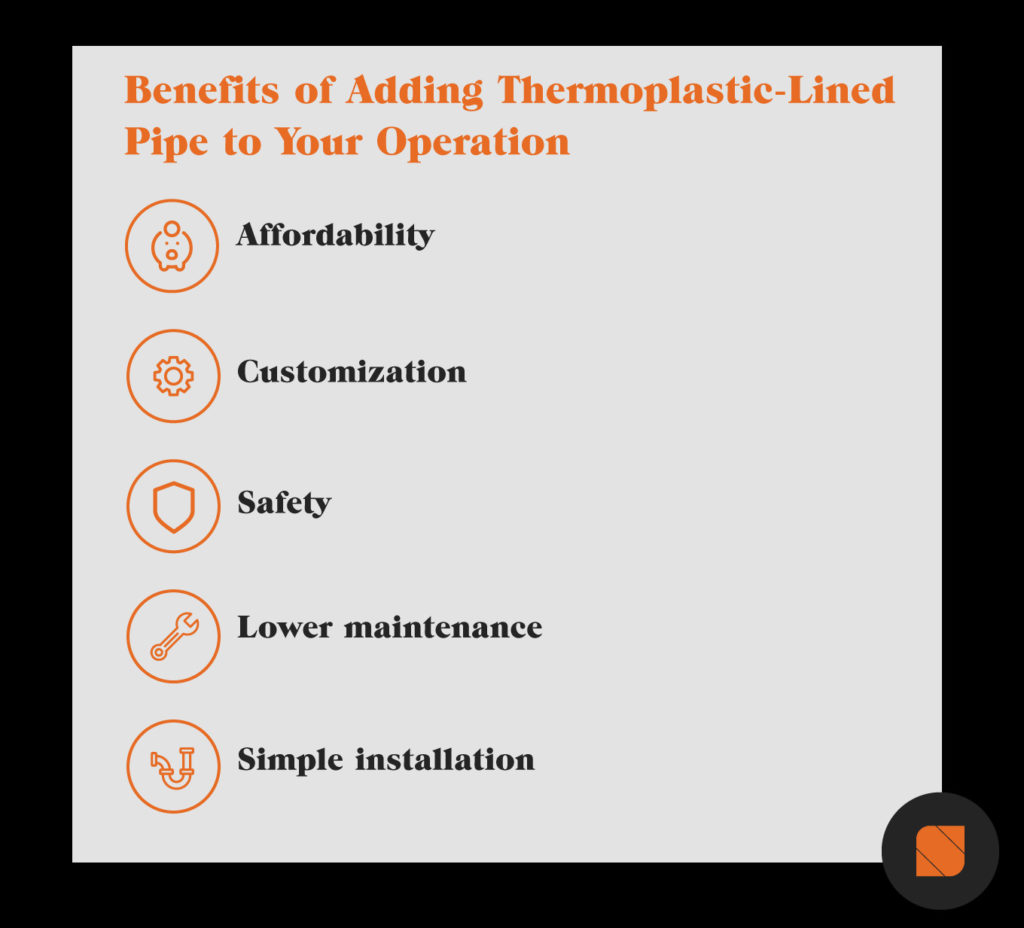
For most standard manufacturing facilities and other industrial applications, there are several benefits of plastic-lined pipe and fittings. Some of the most notable advantages of this type of pipe material include:
- Affordability: By combining the excellent resistance properties of plastic lining to the low cost of steel and other metallic materials, thermoplastic-lined pipe and fittings are one of the most affordable piping options for many manufacturing facilities.
- Customization: By adjusting the amount of each material used, you can customize the properties of your lined pipe while still benefiting from each material’s most desirable characteristics.
- Safety: Plastic-lined pipes lead to improved product quality thanks to the lack of contamination from the liquid touching metallic materials. They are also less likely to result in the fouling of materials and the costly downtime that comes along with the cleanup and repair process.
- Lower maintenance: Thermoplastic-lined pipe is resistant to corrosion and chemicals, and it also does not require frequent maintenance or cleaning.
- Simple installation: When installation technicians have been trained properly, lined pipe installation is much simpler, faster and affordable than installing metal pipes.
Which Pipe Material Is Best for Fluid Handling Operations?
To find the best pipe material for fluid handling operations, you must consider several factors about your facility and your fluid handling system. Every manufacturing facility is unique and requires pipe material and fittings for differing applications. When it comes time for you to replace your fluid handling system, be sure to consider each choice carefully and not just do what everyone else may be doing. Just because metal pipe liners work for one facility, for example, does not mean they are also the best choice for yours.
That being said, lined pipe material is often the best solution for most average-sized manufacturing facilities, as it combines the best features of the two most popular small-scale choices — plastic and metal.
Get Custom Pipe and Fittings From SEMCOR
Once you’ve decided which pipe material and fittings might be best for your operation, contact the experts at SEMCOR to start the process of getting them into your building or buildings. We offer the best products for custom fluid handling, including pipe and fittings, valves, hoses and other custom solutions. Plus, all our products are designed with durability in mind, minimizing the need for future maintenance or an early replacement. We can also provide assistance in choosing the right materials based on your facility’s system and needs.
SEMCOR offers a wide range of fluid handling solutions and customizations, including:
- Pipe and pipe fitting fabrications: SEMCOR specializes in rigid piping designed to withstand high-temperature and corrosive environments. We also provide high-quality and standard plastic pipe linings and fittings, including PTFE, ATL PTFE, PVDF and PP lining. If you require custom lining and fabrications, SEMCOR is here to help.
- Hose and valve modifications: SEMCOR offers hoses made of PTFE, metal, rubber and plastic. We also provide PTFE hose crimp fittings, rubber hose clamping fittings and metal hose welding fittings, so each product can be modified to meet your exact specifications. Our valves, actuators and controls come from top industry suppliers and are made of strong, corrosion-resistant plastics so they can withstand the most abrasive fluid transfer. Our design and fabrication options also allow us to create customized valves, actuators and control solutions for any industrial application.
- Custom expansion joints: SEMCOR provides customizable metal and rubber expansion joints from top industry brands like Resistoflex and Hose Master.
Since 1907, SEMCOR has remained committed to answering your questions and delivering nothing but top quality fabrications for your business. To learn more about SEMCOR fluid handling products and services, or to request a quote, reach out to us online or at (314) 300-0432.
Both our service and sales teams are available 24/7 to assist you and answer any questions you may have. Get in touch with us today, or keep browsing our site to learn more about our fluid handling solutions, including our high-quality lined pipe and fittings.
Why Is Fluid Handling Needed for Manufacturing?
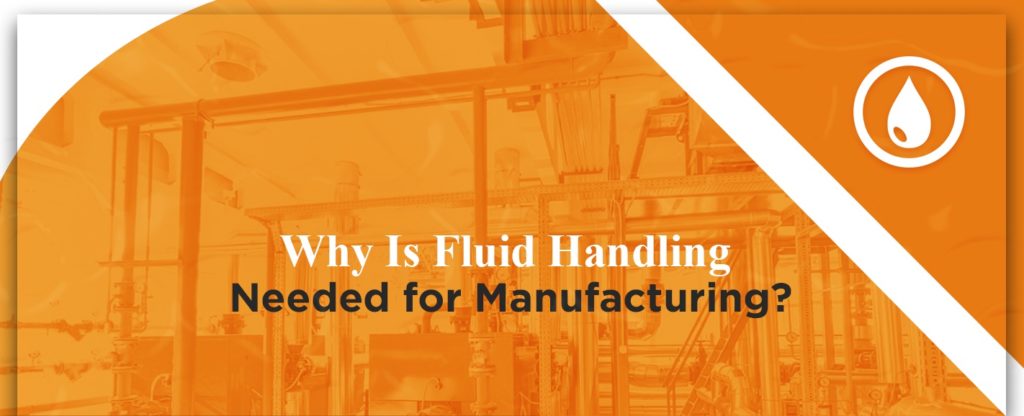
Fluid handling systems play an integral role in many manufacturing industries. For facilities that use fluid handling equipment, it’s not enough to have a system in place. Like other parts of a manufacturing facility, the fluid handling system must have a design optimized for efficiency. Improving the effectiveness of a fluid handling system can make the entire facility operate with less waste and greater longevity.
When looking into options to make your facility operate better and cut time and product losses, consider upgrading the fluid handling system. Newer parts are designed with greater durability in mind, making them better for long-lasting systems. Better equipment translates to more productivity and efficiency.
An Overview of Fluid Handling
The fluid handling system directs, measures and maintains the flow of liquids or fluids throughout the facility. Everything from liquid chemicals to fluid gas can pass through one of these systems. Since many fluid handling systems must withstand high pressures, the components must be durably constructed and long lasting. Typical components of fluid handling systems include the following:
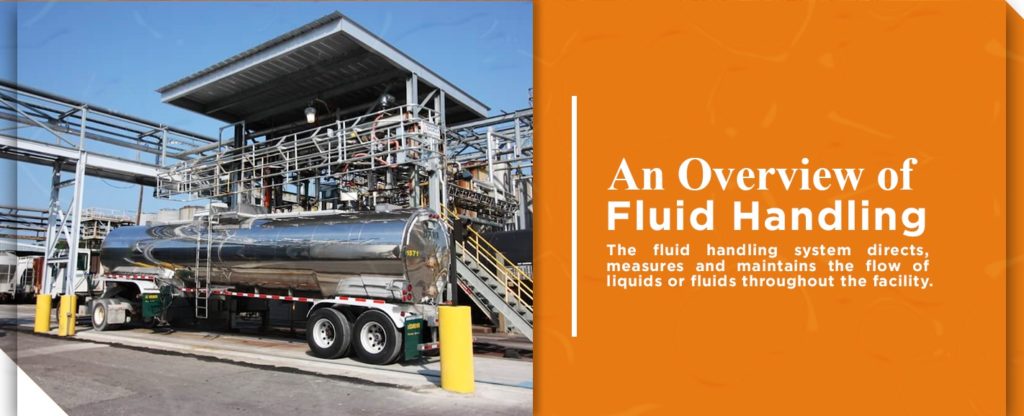
- Piping: Piping must be durable to carry the fluid throughout. The fluid handling designer will choose pipe material based on the temperature and pressure of the liquid carried throughout the system.
- Fittings: Fittings ensure tight connections between pipes. The connections depend on the material of the pipes.
- Expansion Joints: In systems with high temperatures, expansion joints help absorb the changes in the material caused by the temperatures. Some expansion joints will also help reduce vibrations in the pipes.
- Valves: Valves control when fluids pass through the system. The timing of the valves is critical for the operation of the system.
- Hose: Hose can be made from plastic, metal, PTFE, composite or rubber. The connections for hoses will depend on the hose’s material. For example, metal hoses need welding, whereas PTFE hoses get crimped into place. Which one you pick depends on how you will use it. PTFE hoses can transport liquids up to 500 degrees Fahrenheit, but composite hoses work best for cryogenics and hydrocarbons.
- Pumps: Pumps help the fluid in the system reach the appropriate pressure to flow through the pipes to its destination.
Industrial Applications of Fluid Handling
Several industries require fluid handling. The types of fluids used will determine the design of the system. Understanding your industry’s requirements makes it easier for a company to create the fluid handling system your facility needs. Be ready to convey your company’s needs and what you manufacture to get the most effective handling system.
Food and Beverage Manufacturing
The food and drink industry uses fluid handling equipment to transport liquids across the facility. Predictions made for 2017, suggested that pumps would be the most substantial portion of the fluid handling market due to their numerous uses. Like other industries that use fluid handling systems, the food industry has many applications for pumps, but with additional requirements for sanitation not seen in other sectors.
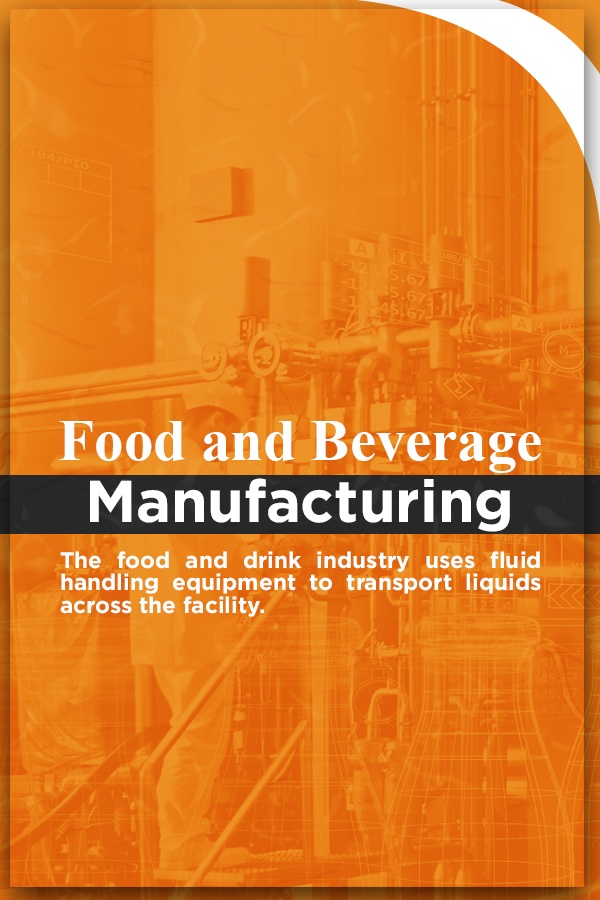
The FDA and USDA require sanitary conditions for systems that transport foodstuffs. Sanitary pumps in the fluid handling system may be jet, airlift, centrifugal or positive displacement types, depending on the force required. The most commonly used sanitary pumps are centrifugal and positive displacement. The latter variety is used for viscous or particle-containing products such as batters, frying oil and deboned meat. Centrifugal pumps are used for moving liquids such as milk, syrup and beverages.
Due to their design that allows for sanitary operation, these types of pumps are expensive to replace. Regular maintenance reduces the chances of severe problems occurring. Filters before the pumps, pressure sensors, current sensors and vibration sensors should all be used with the pumps to prevent problems. The data from these will also help you to determine when to schedule maintenance before the pump breaks down, causing downtime.
Medical Industry
A carefully crafted fluid handling system has proven to save costs in diagnostics. In designing bioreactors, which require oxygen and air pumped into them, a manufacturer was able to settle on a fluid handling system. The system successfully supplied the bioreactor with the necessary gases, including oxygen and nitrogen. The reactor itself is used in research and development in the biopharmaceutical industry. With highly efficient single-use and reusable bioreactors, facilities could lower their costs and reduce maintenance time. These results would not have been achieved had the bioreactors not had functioning fluid handling systems to supply them with air.
Another instance of a fluid system used to improve the medical industry is the ACAPELLA-1K. This system can prepare 1,000 samples for DNA sequencing in only eight hours. It processes so quickly due to its multifunctional system of fluid processing. The system combines the abilities to aspirate, dispense, mix, transport and thermally prepare fluids. Upgrading to this newer fluid system allowed the lab to reach processing speeds never seen before.
Water and Wastewater
The most significant portion of the fluid handling market is the water and wastewater industry. With numerous facilities integrating automation into their operations, they need to upgrade to more efficient fluid handling systems. Several factors are driving the increase in water and wastewater facilities increasing the need for new fluid handling systems:
- Rising Urban Populations: As more people move into urban areas, municipal wastewater treatment requirements rise. More people will also increase the need for freshwater treatment facilities.
- Industrial Expansion: Industries produce considerable amounts of waste. Many industrial plants have on-site wastewater treatment facilities. As manufacturing plants increase in size, so will the waste they create as well as the water they need. Both necessitate more fluid handling equipment to take on the larger loads.
- Energy Concerns: Wastewater and water facilities are under increasing pressure to become more energy efficient. Trading in inefficient fluid handling equipment for more environmentally friendly options will help cut energy usage and reduce waste.
- Need for Increased Efficiency: Lowering costs for the facility will require greater efficiency. The heart of water and wastewater facilities is the fluid transport equipment.
The Benefits of Fluid Handling Equipment for Manufacturers
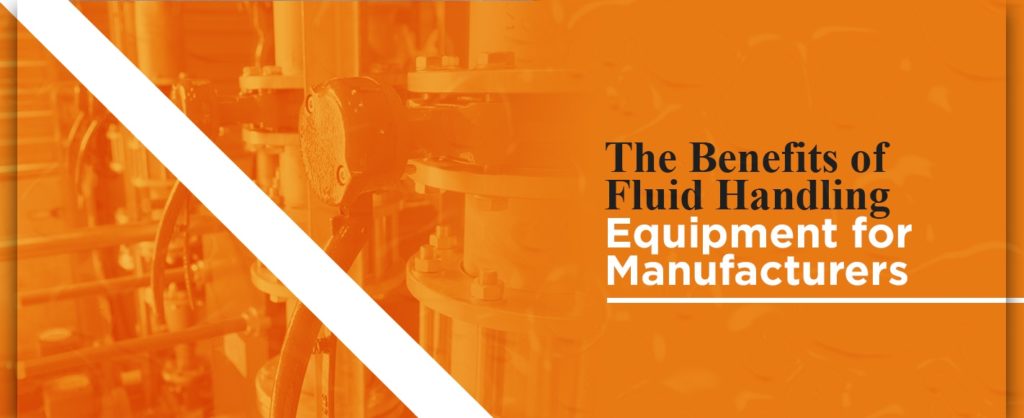
Investing in your own fluid equipment brings control over the liquid or gas into your facility. With more control over the components used to create your product, you can improve your manufacturing system. If you already have a system, consider its age and efficiency with these questions:
- Are you repairing the system more often than you are conducting routine maintenance?
- Do you need ways to cut costs?
- Is your system old and wearing down?
- Do you need your facility to become more efficient?
If you answered yes to any of these questions, it’s time to reevaluate your fluid system. You could reap the benefits of a newer, more efficient system, such as these:
1. Reducing Wear
The type of equipment used for fluid handling can determine the level of wear on the system. Several problems with premature wear can be caused by poorly designed or outdated fluid systems. Improving the equipment can reduce the chances for these problems to occur while making the overall system more efficient. Reducing the amount of strain on individual parts and wear on your system will lower downtime and raise productivity.
2. Eliminating Issues Like Water Hammer
A water hammer can occur in pipes, causing swaying of the pipes and requiring frequent repairs. This issue happens when a control valve opens too quickly. Air can get into the pipes, creating gaps between water amounts. As the water moves through the pipes, the air can push it hard against turns in the lines.
The water slams into the pipes at the corners, creating a loud hammering sound, giving the phenomenon its name. A well-crafted fluid handling system will have control valves more precisely timed to prevent water hammers. Additional support at vulnerable turns can stabilize the lines, too.
3. Having the Most Efficient Parts
If you have an old fluid handling system, your existing valves may be oversized. Replacing them with correctly sized valves will reduce the wear on the valves and increase efficiency. With oversized valves, the openings are not as wide as they should be. When the fluid flows through the smaller opening, it moves with increased pressure, wearing the valve faster.
Oversized valves also have the problem of changing how the system operates. With less fluid running through than expected, the system’s controller won’t tune correctly. An undersized valve is just as bad. It will not let enough flow through the system.
The wrong type of valve will also have a negative impact on your system, and changing it out for a better valve for your needs will increase efficiency and reduce wear on your whole system. For example, vertically using a floating ball valve without enough pressure will cause the system to leak, reducing its efficiency because the low pressure will not allow the valve to seal. A material that is incompatible with the liquid in the system will also wear out early, especially with high temperatures and caustic substances. For instance, a carbon steel valve cannot be used with sulfuric acid because the acid will eat through the carbon steel.
4. Lowering Maintenance Costs
With components designed to wear out less frequently, you will enjoy lower maintenance costs and the subsequent downtime from repairs. Older systems will need more frequent maintenance due to wear on the parts.
If you upgrade to a newer fluid handling system, you will have pieces that have not worn out. Modern components are also designed to have longer intervals between repairs.
5. Improving Pumps With Better Bearings
By upgrading to more modern fluid system parts, you’ll lower your maintenance costs. One example of this is the bearings used in contemporary fluid pumps. These bearings are designed to last longer than older models. Another way newer bearings makes a difference is the type used in the pump. For instance, tapered roller bearings steal energy from a positive displacement rotor unlike angular contact ball bearings, which are much more efficient. Changing the bearings in a pump is a small way to improve the operations of a pump and the entire fluid processing system.
6. Filtering for Longer Life
Filtering fluids before they enter your system reduces the chances of contamination that can ruin the system. With filters installed, you can remove sediment from the liquid in your system, which can help reduce failures — as well as cut down on the maintenance time and money you must spend to get your fluid handling system back up and running.
7. Reducing Product and Time Loss
When your fluid system experiences an unexpected shut-down, you will lose productivity during the downtime. With a more reliable system, though, you won’t have as much downtime to repair problems. Increased reliability means more time for your workers to do their jobs.
In addition to saving time, new fluid handling systems can cut product losses. Inefficient systems that leak can cost you in lost product. The investment in a new liquid or gas handling system can prevent product losses and time wasted.
8. Increasing Product Efficiency
A specific way liquid handling systems waste products is the case of open systems. If you currently have an open fluid handling system, you risk spills of costly and potentially dangerous substances. With a closed system, your workers can more effectively empty a drum. The amount of liquid that can be drawn from a drum in a closed system is 99 percent or higher, reducing unused fluids at the bottom of storage containers.
While using more product from a container is helpful, your employees’ time is handled better. A spill from an open system requires immediate cleanup. A worker who has to stop what they are doing to clean up a spill loses efficiency. By preventing spills and getting more liquid from the container, closed fluid handling systems automatically increase productivity while reducing product and time loss.
How SEMCOR Can Help With Fluid Handling
SEMCOR has the solutions for manufacturing facilities looking to install fluid processing systems. We also have the components necessary to upgrade fluid handling systems. Find everything from valve modifications to expansion joints and pipe fabrications. We carry products for all industries, including sanitary parts for food manufacturing and chemically resistant components for pharmaceuticals.
If you cannot locate what your facility needs on our website, we do offer customization for most parts we sell. Tell us what you need for your facility, and we will work with you to create the components you require. Our service area includes the Midwest up to a 300-mile radius from our base in St. Louis, MO. Contact SEMCOR for solutions to any manufacturing fluid handling system needs. For more information about us, our product line and prices, you can also use the same contact form.
Limit Switches Applications & Functions
Limit Switch Applications & Functions
If you work with electrical machinery, then you’ve probably heard the term “limit switch” before. But what exactly is it? And what is the function of a limit switch? Below, we provide you with a basic overview of what limit switches are, their applications and how to use them.
What Is a Limit Switch?
A limit switch is a piece of electromechanical equipment that’s made up of an actuator connected to a series of contacts. These contacts allow the limit switch to detect the presence and proximity or absence of a material or object, usually in industrial settings. Based on what the contact detects, the sensor moves an actuator, which in turn changes the state of an electrical circuit. This movement signals that some preset ‘limit’ has been reached.
Because limit switches automatically detect preset limits, they eliminate the need for human workers to monitor those levels. This change makes operating everything from heavy machinery to industrial conveyor belts not only much easier and more precise but also much more reliable. As a result, production becomes more efficient, and work environments become safer.
Limit Switch Applications and Functions
Uses of a Limit Switch
Limit switches are often used to tally items or materials so that when a limit is reached, the switch closes or opens. This condition is frequently the case in industrial applications such as assembly lines. For example, when the limit switch in a specific piece of equipment detects that it has added a predetermined number of components to a product, the switch moves the actuator, which in turn moves the piece of equipment away, and the product goes on to the next station.
Limit switches can also be used as safety interlocks to prevent machine parts from moving any further when a specific point is reached. A good example of this is an automatic garage door. Without a limit switch that stops the door when it reaches the bottom rail, the door would keep moving downwards and eventually crash into the ground, causing serious damage.
Limit switches can also be used as part of a larger control system. When a certain limit is reached, the actuator can de-activate or activate a device to prevent malfunctioning or emergencies.
How to Use a Limit Switch — Operating Principle
The limit switch operating principle is rather simple, but as you can tell from the examples above, it’s integral to a host of industrial and commercial mechanical operations. Its most basic use is to slow down, stop, start or speed up operations. You can integrate a limit switch into a wide range of electromechanical applications ranging from residential garage doors to material handling in warehousing and distribution.
Limit Switch Supply
Various types of limit switches exist, including:
- Snap switches
- Heavy duty oil-tight switches
- Gravity return switches
- Safety locking and unlocking switches
Contact us today to learn more about our inventory of limit switches for valve operations!




